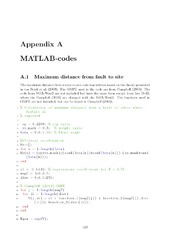| dc.description.abstract | Towards the end of the last glacial period, several episodes of submarine mass failures has taken place both in Norwegian fjords and on the continental shelf. Submarine mass failures have the potential of generating tsunamis which can cause great harm to coastal communities and offshore infrastructure. Because slides on the continental shelf can be initiated on slopes with low inclination, it has been assumed that an external trigger mechanism is required to initiate failure. Earthquakes is one of the suggested trigger mechanism for slides on gentle slopes. The Storegga slide, which occurred offshore Norway approximately 8200 years ago, may have been triggered by an earthquake. The slide generated a tsunami that had a run up height of 10-12 meters. There exists several large faults in the area of the Storegga slide, which have the potential of generating earthquakes of relatively high magnitudes. In the area, two earthquakes with a magnitude above 5 was recorded in 1988 and 1989. It is assumed that the area can also experience earthquakes with this magnitude also in the future. This study has performed modeling of 14 faults located in the Storegga area. The critical acceleration, or the ground motion required to initiate slide has been calculated. Two different ground motion prediction equations depending on magnitude and distance have been evaluated together with the critical acceleration to calculate the maximum distance from fault to initiation area for an earthquake to be the responsible triggering mechanism for slides. The program EXSIM12 was used to model the resulting ground motion from earthquakes with a magnitude of 5 to 7. The sediment response to earthquakes has been evaluated with the program DEEPSOIL. The pseudo-static limit equilibrium method has been used to obtain an index of stability, and a seismic-induced permanent displacement equation has been used to calculate the permanent displacement that could occur in a slope as a response to an earthquake. The results indicate that the stability of the slope considered is very stable on low slope angles, and a higher slope inclination would be required for an earthquake to initiate failure. | en_US |

